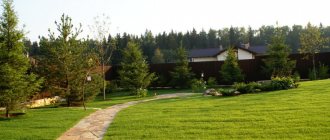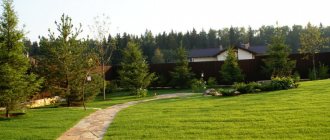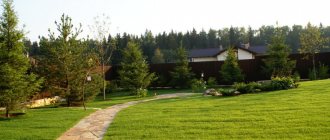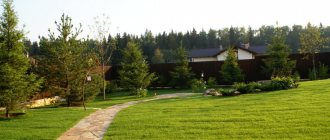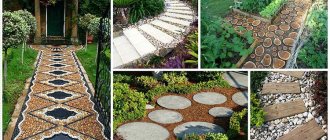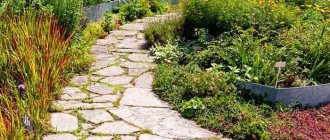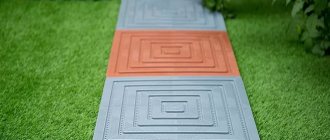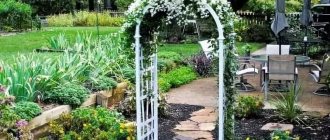Gravel path
This is a budget option for designing a country path. Thanks to its structure, gravel will perfectly allow water to pass through empty areas, which will allow you to walk comfortably in rain and mud.
This material will help you easily give the desired shape for the garden path, which can always be changed or supplemented. This is a simple, effective and mobile option for landscaping.
One of the disadvantages is that gravel perfectly allows weeds and grass to pass through. And it will have to be cleaned periodically. Like any number of small elements, gravel is difficult to keep in one position. And to maintain the integrity of the design, it is better to use borders for garden paths.
Low-growing flowers for the border, annuals and biennials
The main advantage of annual flowers over perennials is that there are so many varieties among them that every year you can create an original design that is not repeated from year to year.
Annual plants for border decoration
Annual flowers for borders along paths have their advantages:
1. By combining several varieties, you can create a colorful flowerbed to frame a tree on your lawn.
2. Acceptable cost of seedlings. This plays a big role, especially when the borders are long and you will need to buy many copies.
3. Flowering paths look decorative throughout the warm season, right up to the onset of frost.
4. Every year you can create new compositions from different varieties of plants.
Among the disadvantages of annuals for decorating borders are the labor costs: every year you have to sow seeds for seedlings, pick and plant them.
To make your work easier and avoid sowing seeds at home and subsequently caring for the seedlings, you can buy flowers whose seeds can be planted directly into the ground, without seedlings. These are marigolds, lobularia and calendula.
In order to save the family budget, you can grow seedlings yourself. Depending on the variety and climatic conditions of the area, sowing seeds for seedlings is carried out in January-March. Seedlings can be bought ready-made.
The following are often used in border decoration: purslane, low-growing marigold, allisum, zinnia, and Chinese aster.
You can plant annual crops that continue to bloom until frost. Preference should be given to:
- brilliant sage;
- lobelia;
- Hawker's balsam;
- ashen ragwort;
- evergreen begonia;
- ageratum.
Marigold
Thanks to their ease of care, long-lasting and abundant flowering, marigolds occupy a leading position in popularity in the design of borders along paths. I'm pleased with the length of flowering. In June, red, burgundy, orange, yellow, and lemon flowers appear. Flowering can only be interrupted by frost.
Marigold
For cultivation, it is advisable to choose low-growing varieties with a stem height of no more than 30 cm. However, the rich, bitter aroma of flowers is not suitable for everyone. In this case, the planting can be taken away from the house and used to decorate the area near the fence or used as an edging for the border.
Everblooming begonia
To design paths you need to choose low varieties. Begonia blooms in June and fades in October. All this time it pleases the eye with red, salmon, white, orange, yellow flowers. The main advantage of the species is the ease of growing seedlings. Begonia everblooming is especially beautiful in perimeter plantings and for delineating borders.
Begonia
Balsam
Annual plant. During the growing season, the height of low-growing bushes does not exceed 15 cm. Long-term flowering with simple and double flowers, sometimes two-colored. Impatiens tolerate light shade, so balsam can be planted in the partial shade of the garden. Impatiens are also suitable for planting along the edge of the lawn.
Balsam
Ageratum or longflower
In its natural growing environment, ageratum is considered a perennial plant; in our conditions, it can only be grown as an annual crop. The height is 25-30 cm. In early June, white or purple ageratum flowers bloom above the green mass. Flowering continues until frost. As it grows, it creates a dense carpet, which is why the long-flowered plant is popular in border decoration.
Flowers for the border along paths Ageratum
Salvia splendor or salvia
The decorative fire plant reaches 25 cm in height. Does well in a sunny area. Red salvia is the most popular variety. You can move away from the canons and grow sage in other shades: purple, salmon, white. The border biennial blooms in June. Blooms all summer and autumn.
Salvia
Flowers for the border, low-growing biennials
Growing biennial flowers takes a lot of time: first you need to sow the seeds, grow the seedlings and plant them in a permanent place. There will be no flowering in the first year. Only in the second year after planting can you admire the flowering. It is preferable to plant pansies, forget-me-nots, chamomile or lacfiole.
Decorative cabbage
The biennial plant reaches a height of 30 cm. A notable feature of the crop is its multi-colored rosette, the coloring of which occurs at low temperatures. It is especially decorative in autumn and decorates the garden at the beginning of winter.
Decorative cabbage
The leaves have a wide color palette; they can be yellow, violet, red, purple, rich light green, white and cream. What’s remarkable is that this entire range of colors can be simultaneously present on one copy.
Looks great in the design of low borders and flower beds. Good in combination with other annual or perennial plants.
Pansies
The herbaceous perennial plant is popular in edging paths or used to create borders. But the Wittrock violet will only act as a spectacular plant and look beautiful if seedlings of the same variety are planted in one row. Viola is easy to grow and can withstand light trampling. Flowering lasts from March to October.
Pansies
Daisies
Depending on the variety, daisies grow to a height of 4 to 20 cm. Flowering in a two-year-old plant is observed in the 2nd year.
Daisies
It is important to know! An interesting feature of the crop is the variability of its growth. The daisy adapts to the specific conditions in which it grows. For example, if it has settled on the lawn, the flowers will bloom on short stems so that they cannot be cut off by a lawn mower.
The bladed leaves are collected in a rosette. Thanks to breeding work, many varieties with red, orange, pink, white, and multi-colored flowers have been developed. The daisy is the queen of the garden, just like the rose.
Using lawn to create a path
What are the nuances when making garden paths from lawn? To maintain an attractive appearance, the lawn requires constant care. Watering, weeding and cutting.
It is also important to have constant natural light. With constant use, it quickly gets trampled, bald spots appear and the overall appearance deteriorates.
One of the advantages is that with proper care, the path looks very beautiful and creates a feeling of comfort and well-groomed. In addition, it is pleasant to walk on it.
There is an interesting life hack for caring for such a path. To make lawn maintenance easier, choose a width that matches the width of your lawn mower. This will save time significantly.
Advantages and disadvantages of perennial flowers
An undeniable advantage of perennial crops in the design of borders is the ability to be restored annually. I worked hard once and forgot.
One of the significant disadvantages is short flowering in comparison with annuals and biennials.
Perennial flowers and shrubs, popular among summer residents
In landscape design, flowers often used for borders along paths are perennials:
- low-growing dahlias;
- subulate phloxes;
- arabis;
- Byzantine chistets;
- Carpathian bell.
You can choose cultivated aubrietta, low-growing chrysanthemums, dicentra, creeping tenacious, gray-blue carnations.
Of the perennial shrubs, you should pay attention to euonymus and lavender. In order for borders to look compact and decorative throughout the season, it is recommended to carry out timely pruning. A long-term option is to plant boxwood or low-growing barberries. Varieties have varieties with multi-colored leaves, which enhances their decorative qualities.
feathery carnation
Feathery carnation
The height of the low-growing plant reaches 30 cm. The narrow blue-green leaves of the carnation, collected in a bunch, look beautiful. In May, the plant is covered with pink or white flowers. Does not like waterlogged soil.
Narcissus
Popular bulbous plant. When creating borders, one must take into account the fact that daffodils bloom in the spring, then the green mass dies. The height of individual varieties ranges from 25 to 40 cm. It blooms with orange, yellow, and white flowers. You can find two-color varieties.
Narcissus
Khosta
An ideal plant for borders. You need to choose low-growing varieties. Hosta is good because it can grow in the shade, so it is considered a good option for decorating shady corners of the garden.
Perennial flowers popular among summer residents
Sedum prominent
The sedum, or, as it is called, the ice plant, reaches a height of 40 cm during flowering. Oval leaves with jagged edges sit on thick shoots. Flowering occurs in the second half of summer and continues in autumn. The flowers are pink.
Sedum prominent
Lavender
Suitable for planting in Provence style gardens. Perennial flowers for borders are considered the most beautiful. They can be used to decorate areas near paths.
Lavender
Purple and lilac lavender flowers enchant with their tenderness and pleasant aroma. In July-August there is abundant flowering. The height of the plant is 0.6 m. There are varieties with high resistance to frost.
Lavender thrives in sunny areas protected from gusty winds. Grows best on slightly alkaline soil, air- and water-permeable.
Small-flowered heuchera
The evergreen perennial crop is planted in high ridges; the surface can be decorated with heuchera. The height of the plant is 0.6 m. Paniculate inflorescences with small pink or cream flowers bloom above the beautiful foliage. The advantages of heuchera are its curly leaves, colored purple or green.
Heuchera
Heather
The plant blooms from July to October. The flowers look like cups with curved leaves. They are located at an angle in relation to the stem. It is better to plant the crop in several copies so that they have a natural appearance. Depending on the variety, red, white, purple, and pink flowers bloom.
Perennial flowers, heather
Planting of the bush should be done in a bright sunny place. It should be noted that plants prefer acidic soil and do not tolerate excessive moisture. Despite the fact that heathers are considered frost-resistant, it is recommended to cover young seedlings with agrofibre. To maintain decorativeness, regular pruning is necessary, which is carried out after flowering, cutting off the shoots below the peduncles.
Bloodroot
It is advisable to design in one tone, that is, plant varieties with either red, white or yellow flowers next to them. The height of the plant is 1 m.
Bloodroot
In June, orange, light red, white or yellow flowers appear above the silver-green foliage. It gained popularity due to its resistance to low temperatures, diseases and pests, and soil. Tolerates drought well. Needs regular pruning. In spring, it is necessary to remove all damaged, frozen, dry and diseased shoots.
Erika
A notable feature of the plant is its flowering time - February-April. At this time, pitchers bloom on the bush. The leaf blades look like needles and are located perpendicular to the stems. Grows well in slightly acidic soils, moderately moist with good air permeability. Can be successfully grown in sunny areas or in partial shade.
Erika
Japanese spirea
Frost-resistant shrub. Not susceptible to diseases and pests. Leaves are the pride of Japanese spirea. Depending on the season, the sharp oblong foliage changes color. The height of the crop is 1 m. Flowering begins in June and continues until September. It blooms with small white or pink flowers collected in clusters.
Japanese spirea
The shrub grows well in fertile soil. The ideal planting option is a bright place, but it will not disappear in partial shade either. Pruning should be done in spring. Does not react to air pollution, is resistant to frost and pests, and temporary heat.
The plants described will help you decide what flowers to plant along the paths: perennials , annuals or biennial crops; you can opt for shrubs.
Tile path
Paving slabs add a sense of elegance to the space. The main feature is the minimum requirements for care and maintenance. With high-quality installation, tiles will serve you for many decades. And keep a well-groomed appearance.
But there are also disadvantages to this style. First of all is the price. This type of design is considered the most expensive. Even DIY installation will not help reduce costs.
Some tips for laying paving slabs yourself:
- To add more rigor to the design, use a garden border.
- The tiles must be laid when it has not rained and will not rain for at least a week. This is the most important condition. It is its compliance that determines the service life of the track.
- If you live in an area with heavy and prolonged rain, you should consider drainage for the path.
What materials can be used for construction
You can choose any material for construction, but the design of paths in the garden should not disrupt the overall style of the site and be in harmony with the house.
Classic made of concrete
Durable and easy to manufacture, monolithic concrete strip is a timeless classic in the design of a path to a house. Inconspicuous gray stripes will decorate borders of coniferous plants, evergreen shrubs, flowering perennials or an unusual mosaic of shells, pebbles, glass inclusions, skillfully laid on top of the hardening solution.
Advice. A cast concrete path, with pebbles or crushed stone poured into the technological seam, will give the impression of a sidewalk made of individual slabs.
Natural brick
Ordinary brick is no less popular and affordable material than cement. Whole bricks, halves and even small fragments laid out in various patterns make it possible to show creativity and create unique masterpieces of garden path design.
Brick paths easily withstand weather anomalies and do not get lost among green grass or yellow autumn leaves.
Gravel and crushed stone
Paths made of crushed stone and gravel go well with flower beds, rock gardens, rock gardens, and alpine slides; patterns of colored crushed stone and pebbles look impressive surrounded by low, lush bushes.
Paths made from bulk materials can be decorated with original borders made of stumps, bricks, glass or plastic bottles. Bulk paths do not require special care; small pebbles provide good drainage, but they are difficult to remove leaves from.
Important! Bulk coverings are dangerous for children: a child may choke on small pebbles while playing.
Clinker brick
Clinker or burnt brick differs from ordinary brick in its high strength, moisture resistance and a variety of shades: brown, yellow, bluish-gray. It can withstand significant loads and can be used to pave a car area.
river stone
The simplest river stone can turn a path into a work of art. By selecting a sufficient number of light, gray and dark stones of similar shade, you can lay out any picture or ornament. This is long and painstaking work. But the resulting design will be absolutely unique. And you can be proud of yourself, listen to rave reviews from friends and family.
First of all, it is necessary to sort the stones by color, and also get rid of defective stones and stones with obvious flaws. To facilitate further work, you can sort the stones by size.
It is important to create a feasible sketch of the future path. You can use ready-made ideas from the Internet or come up with your own design. It's easiest to style curls or squares.
Planting plants in a flower bed
The next step for the gardener or landscape designer is to optimally plant flowering crops. To do this, most often follow the instructions on how to make a discount:
- The selected area is marked with pegs and rope.
- Next, you need to remove the top layer of soil, which is 10-15 cm.
- Border material is laid along the edges of the future flower bed. This could be stone, broken gravel, masonry, decorative borders made from glass bottles. Fencing is an important element of any flowerbed, which prevents excessive plant growth and favorably emphasizes the style of the flowerbed.
- Mix nutritious soil, the composition of which depends on the varieties of plants chosen for the flower garden. It is better to purchase the soil from a specialized store or treat it yourself against pests and fungi. With this approach, plants will be maximally protected from the action of pests, fungi and various microorganisms.
- The soil is laid on the prepared site and leveled.
Flowers are planted according to the prepared scheme. It should be remembered that the central rows are occupied by the tallest plants, and the periphery is intended for planting low-growing crops. In practice, you can find ridges that have only one tier.
Path using tree bark
Bark is a cheap material that can be purchased at any hardware store. An interesting feature of the bark is that it prevents weeds from growing. Accordingly, such a path will require a minimum of care and time.
Flaws:
- it is necessary to add bark to the path every season;
- Some of the material is carried by the wind or on the soles of shoes, which also affects the need to add bark to some areas.
Features of choice
There is nowhere in the country without garden paths, and sooner or later the inhabitants will trample narrow paths to the toilet, to the vegetable garden, to the barbecue. Only the quality of these paths will be much worse than any made by yourself. They:
- quickly overgrown with grass - once you return to the dacha after a long winter absence, you will find that the paths can no longer be found in the green thickets;
- are washed away by rain - as soon as the weather turns bad, and instead of paths you will have grooves filled with water, which are impossible to walk along.
DIY garden paths
Even with a small budget, it is necessary to make comfortable paths. There are many ways to do this.
